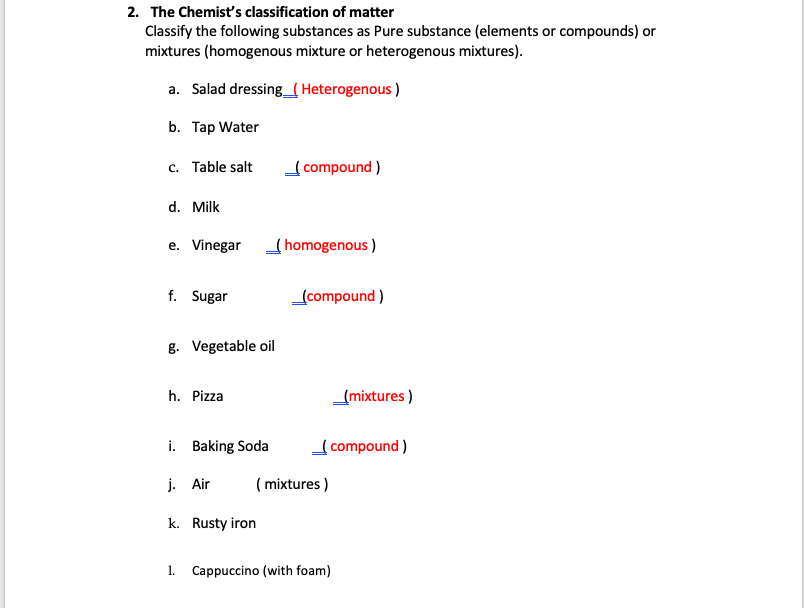
Chemistry
10th Edition
ISBN: 9781305957404
Author: Steven S. Zumdahl, Susan A. Zumdahl, Donald J. DeCoste
Publisher: Cengage Learning
expand_more
expand_more
format_list_bulleted
Question

Transcribed Image Text:2. The Chemist's classification of matter
Classify the following substances as Pure substance (elements or compounds) or
mixtures (homogenous mixture or heterogenous mixtures).
a. Salad dressing_( Heterogenous )
b. Tap Water
c. Table salt
compound )
d. Milk
e. Vinegar
(homogenous )
f. Sugar
(compound )
g. Vegetable oil
h. Pizza
(mixtures )
i. Baking Soda
compound )
j. Air
( mixtures )
k. Rusty iron
1.
Cappuccino (with foam)
Expert Solution
This question has been solved!
Explore an expertly crafted, step-by-step solution for a thorough understanding of key concepts.
This is a popular solution
Trending nowThis is a popular solution!
Step by stepSolved in 2 steps

Knowledge Booster
Similar questions
- 5. Indicate whether the following statements best describes a solid, liquid, or gas a. It has an indefinite shape but a definite volume. b. It takes the shape and volume of the container. c. The particles are packed closely together and have very little movement. d. The particles are far apart and move very rapidly. 6. Consider the following classifications of matter: heterogeneous mixture, homogeneous mixture, element, and compound. a. In which of these classifications must two or more substances be present? (There is more than one answer.) b. In which of these classifications is separation into simpler substances using physical means possible? (There is more than one answer.)arrow_forward1.Can the states of matter change from one form to another (ex solid to liquid)? Yes or No? How? 2.What do you call the change in the state of matter? 3.What are the processes involved in phase change?arrow_forward3. Which of the following states of matter has a fixed volume and a fixed shape? a. Liquid b. Solid C. Gas d. Solution e. Heterogeneous mixture O a b O c d. earrow_forward
- Which of the following properties describes a liquid? A. Particles are less rigid so they are able to flow around each other. B. High density because the particles are closely packed together. c. Have a fixed shape and volume. D. Particles have high kinetic energy. E. None of these describe a liquid.arrow_forward7. A student combines pure NaCl (sodium chloride) with pure DI water. The resulting is an example of: a. homogeneous mixture b. heterogeneous mixture c. pure substance d. suspensionarrow_forwardDuring a chemical change: A. Chemical composition changes B. There is only a physical state change C. There are no changes D. Solids are always formedarrow_forward
- Please answer all questions thank youarrow_forwardWhich is considered an elemental substance? A.CO (carbon monoxide) B.H2O (water) C.I2 (iodine) D.A and C are elemental substances. E.All of the above are elemental substances.arrow_forwardTo the best of your knowledge, classify each of the following as an element, A compound, or a mixture. If it is a mixture, classify it as homogeneous or heterogeneous. a. Silver coin b. Air c.coffee d.soilarrow_forward
- classify each as homogeneous or heterogeneous. a bowl of oatmeal,tea,vegetable pulp salad,juice witharrow_forward20. Which of the following substances would be classified as a pure substance? а. Blood b. Fog c. Steel d. Copper (II) Sulfatearrow_forwardWhat is the classification of the substance in the figure? A. element B. homogeneous mixture C. compound D. heterogeneous mixturearrow_forward
arrow_back_ios
SEE MORE QUESTIONS
arrow_forward_ios
Recommended textbooks for you
 ChemistryChemistryISBN:9781305957404Author:Steven S. Zumdahl, Susan A. Zumdahl, Donald J. DeCostePublisher:Cengage Learning
ChemistryChemistryISBN:9781305957404Author:Steven S. Zumdahl, Susan A. Zumdahl, Donald J. DeCostePublisher:Cengage Learning ChemistryChemistryISBN:9781259911156Author:Raymond Chang Dr., Jason Overby ProfessorPublisher:McGraw-Hill Education
ChemistryChemistryISBN:9781259911156Author:Raymond Chang Dr., Jason Overby ProfessorPublisher:McGraw-Hill Education Principles of Instrumental AnalysisChemistryISBN:9781305577213Author:Douglas A. Skoog, F. James Holler, Stanley R. CrouchPublisher:Cengage Learning
Principles of Instrumental AnalysisChemistryISBN:9781305577213Author:Douglas A. Skoog, F. James Holler, Stanley R. CrouchPublisher:Cengage Learning Organic ChemistryChemistryISBN:9780078021558Author:Janice Gorzynski Smith Dr.Publisher:McGraw-Hill Education
Organic ChemistryChemistryISBN:9780078021558Author:Janice Gorzynski Smith Dr.Publisher:McGraw-Hill Education Chemistry: Principles and ReactionsChemistryISBN:9781305079373Author:William L. Masterton, Cecile N. HurleyPublisher:Cengage Learning
Chemistry: Principles and ReactionsChemistryISBN:9781305079373Author:William L. Masterton, Cecile N. HurleyPublisher:Cengage Learning Elementary Principles of Chemical Processes, Bind...ChemistryISBN:9781118431221Author:Richard M. Felder, Ronald W. Rousseau, Lisa G. BullardPublisher:WILEY
Elementary Principles of Chemical Processes, Bind...ChemistryISBN:9781118431221Author:Richard M. Felder, Ronald W. Rousseau, Lisa G. BullardPublisher:WILEY

Chemistry
Chemistry
ISBN:9781305957404
Author:Steven S. Zumdahl, Susan A. Zumdahl, Donald J. DeCoste
Publisher:Cengage Learning

Chemistry
Chemistry
ISBN:9781259911156
Author:Raymond Chang Dr., Jason Overby Professor
Publisher:McGraw-Hill Education

Principles of Instrumental Analysis
Chemistry
ISBN:9781305577213
Author:Douglas A. Skoog, F. James Holler, Stanley R. Crouch
Publisher:Cengage Learning

Organic Chemistry
Chemistry
ISBN:9780078021558
Author:Janice Gorzynski Smith Dr.
Publisher:McGraw-Hill Education

Chemistry: Principles and Reactions
Chemistry
ISBN:9781305079373
Author:William L. Masterton, Cecile N. Hurley
Publisher:Cengage Learning

Elementary Principles of Chemical Processes, Bind...
Chemistry
ISBN:9781118431221
Author:Richard M. Felder, Ronald W. Rousseau, Lisa G. Bullard
Publisher:WILEY